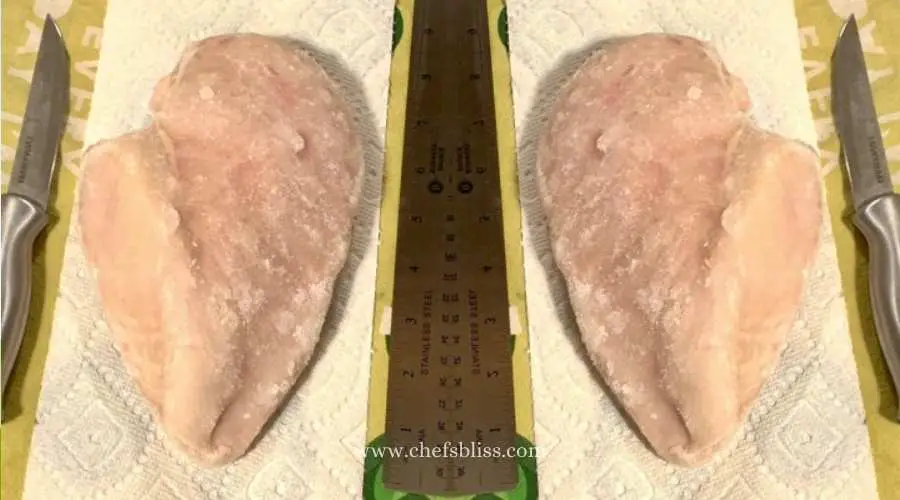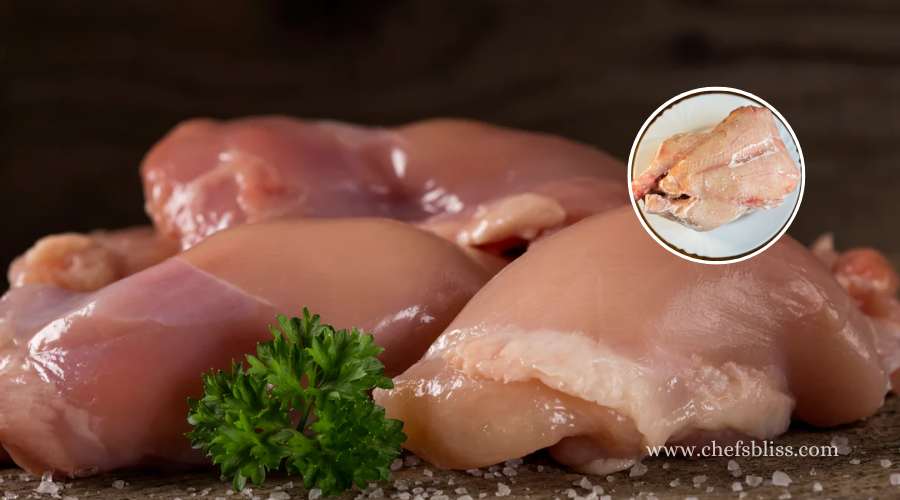Every product is independently reviewed and selected by our editors. If you buy something through our links, we may earn an affiliate commission at no extra cost to you.
Chicken breast is a versatile and healthy protein source enjoyed by many around the world.
However, you might have noticed small white spots on chicken breast and wondered what they are and whether they’re safe to eat.
In this article, I will dive deep into the causes of these white spots and provide you with important facts to put your mind at ease.
What are the white spots on frozen chicken breast?
The white spots on frozen chicken breasts are typically caused by two factors: ice crystals and freezer burn.
Ice Crystals
When chicken is frozen, moisture within the meat can form ice crystals.
These ice crystals often appear as small, white spots on the surface of the chicken breast.
They are a natural consequence of the freezing process and are generally harmless.

Freezer Burn
Freezer burn occurs when chicken is not adequately sealed in an airtight container or freezer bag.
It happens when air comes into contact with the chicken’s surface, causing moisture to evaporate.
This process can lead to the development of white, dry, and sometimes leathery patches on the chicken.
While freezer burn doesn’t make the chicken unsafe to eat, it can negatively impact its texture and flavor.
Why does my raw chicken breast have white dots on it?
White dots or specks on raw chicken breast can be caused by various factors such as connective tissue, fat deposits, calcium deposits, or improper storage leading to freezer burn.
Here are some possible reasons for the presence of white dots on raw chicken breast:
Connective Tissue
Sometimes, the white dots are actually small pieces of connective tissue that have not completely dissolved during cooking.
These are harmless and do not affect the safety or taste of the chicken.
Fat Deposits
Some white spots may be small deposits of fat within the muscle tissue of the chicken.
These fat deposits can appear as white dots, especially in lean chicken breast meat.
Calcium Deposits
In some cases, white spots can be calcium deposits that have formed within the muscle fibers of the chicken.
These are safe to consume but may have a slightly different texture.

Freezer Burn
If the chicken has been improperly stored in the freezer with inadequate packaging, it can develop freezer burn.
This can result in white, dry patches on the meat. While not a safety issue, freezer burn can affect the quality of the chicken.
Brining or Marinades
If the chicken has been soaked in a brine or marinade, it can sometimes cause white spots due to changes in the protein structure or the interaction between the marinade ingredients and the meat.
Age and Processing
The age and processing methods of the chicken can also influence the appearance of white spots.
Younger chickens tend to have fewer white spots, while older chickens may have more due to changes in their muscle tissue.
How can I prevent white spots from forming on raw chicken breasts?
To help prevent or minimize the formation of white spots on raw chicken breasts, you can follow these tips:
Proper Storage:
Store raw chicken in an airtight container or a well-sealed freezer bag to prevent freezer burn. Make sure there is minimal air exposure.
Label and Date:
Label your chicken with the date it was frozen, and try to use it within a reasonable time frame to reduce the chances of freezer burn.
Use Freezer Paper:
Wrap chicken tightly in freezer paper before freezing to create an additional barrier against air and moisture.
Vacuum Sealing:
Consider using a vacuum sealer to remove air and seal chicken in airtight bags before freezing.
Quick Freeze:
Ensure that chicken is fully cooled before freezing to prevent the formation of excess moisture, which can contribute to freezer burn.
Avoid Overstocking:
Do not overcrowd your freezer, as this can lead to inadequate air circulation and uneven freezing, increasing the likelihood of freezer burn.
Proper Thawing:
When you’re ready to use frozen chicken, thaw it in the refrigerator rather than at room temperature. This slow thawing process helps preserve the chicken’s quality.
Marinate Carefully:
If you plan to marinate chicken, make sure the marinade is well-balanced and doesn’t contain excessive acidic ingredients, as this can affect the meat’s texture.
Choose Lean Cuts:
Leaner cuts of chicken are less likely to have visible white spots, so consider selecting these cuts if you find the spots unappealing.
Regularly Clean and Maintain Your Freezer:
Keep your freezer clean and organized to ensure proper airflow and reduce the risk of freezer burn.
Are white spots on raw chicken safe to eat?
Yes, white spots on raw chicken are generally safe to eat. These white spots can be caused by various factors like fat deposits, connective tissue, or calcium deposits and are typically harmless.
When you cook the chicken, these spots usually dissolve, and as long as the chicken is cooked to the recommended internal temperature of 165°F (73.9°C), it is safe to eat.
What are the white spots on cooked chicken breast?

White spots on cooked chicken breast are generally caused by various factors such as connective tissue, fat deposits, calcium deposits, or overcooking.
These spots are typically safe to eat, but their presence may affect the texture and flavor of the chicken.
Proper cooking techniques and not overcooking the chicken can help minimize the appearance of these spots.
White spots on chicken after seasoning?
White spots that appear on chicken after seasoning are typically caused by salt crystals drawing out moisture or by seasoning ingredients with light-colored components.
These spots are a normal part of the seasoning process. They do not indicate any problems with the chicken’s quality or safety.
White spots on chicken after defrosting?
White spots that appear on chicken after defrosting are often caused by ice crystals melting or freezer burn due to improper packaging.
Proper storage and packaging can help minimize their occurrence during freezing and thawing.
Do white spots on chicken breasts indicate spoilage or disease ?
White spots on chicken breasts typically do not indicate spoilage or disease.
These spots are often caused by factors like fat deposits, connective tissue, or calcium deposits within the meat, and they are generally harmless as I mentioned earlier.

However, it’s important to note that spoilage or disease in chicken can manifest in other ways, such as a foul odor, unusual coloration (gray, green, or slimy), or a sticky texture.
Note: If you encounter chicken with any of these characteristics, it is best to discard it, as it may not be safe to consume.
Can I cook chicken with white spots, or should I throw it away?
Yes, You can cook chicken with white spots, as these spots are typically harmless and not a safety concern.
The key is to ensure that the chicken is otherwise fresh, properly stored, and does not exhibit signs of spoilage or disease and If the chicken shows any of these signs, it’s best to discard it to ensure food safety.
Do white spots on chicken breasts affect the taste of the meat?
White spots on chicken breasts typically do not significantly affect the taste of the meat.
While they may have a minor impact on texture and appearance, their influence on flavor is generally minimal.
The overall taste of the chicken is more influenced by factors such as seasoning, cooking method, and the chicken’s quality.
What should I do if I notice white spots after cooking chicken?
If you notice white spots on cooked chicken, there’s no need to be overly concerned. Here’s what you can do if you notice white spots on cooked chicken:
Check for Doneness:
Ensure that the chicken is thoroughly cooked to an internal temperature of at least 165°F (73.9°C).
Cooking chicken to the recommended temperature is crucial for food safety.
Consider Appearance:
If you find the appearance of the white spots unappealing, you can choose to trim or scrape them off before serving. This step is optional and depends on personal preference.
Evaluate Overall Quality:
Assess the overall quality of the chicken. If there are no other signs of spoilage, such as an off-putting odor, unusual coloration, or a slimy texture, and the chicken was properly stored and cooked, it is likely safe to eat.
Serve as Usual:
You can serve the cooked chicken as you normally would, and most people will not notice any difference in taste due to the white spots.
Are there any health risks If I eat chicken breast with white spots?
Eating chicken breast with white spots is generally not associated with health risks.
These spots are harmless and do not pose a safety concern when consumed.
It’s crucial to handle and cook chicken safely to ensure food safety.
Proper cooking and food safety practices are essential when preparing poultry to prevent foodborne illnesses.
Do organic or free-range chickens have fewer white spots on their breasts?
The presence of white spots on chicken breasts is not determined by whether the chicken is organic, free-range, or conventionally raised.
The occurrence of white spots is more related to individual bird characteristics and meat composition than production practices.
If you want chicken with fewer white spots, leaner cuts tend to have fewer visible spots, regardless of production method.
Conclusion
White spots on chicken breast are a common occurrence and are usually harmless.
Understanding their causes and knowing that they do not pose health risks can help put your mind at ease.
While they may affect the appearance of your chicken dish, rest assured that properly cooked chicken with white spots is safe to eat and can still be delicious and nutritious.
Focus on safe handling and cooking practices to enjoy your chicken with confidence.
References
- https://www.thespruceeats.com/what-is-connective-tissue-995836
- https://www.menshealth.com/uk/nutrition/a44751485/white-stripe-chicken-breast/
- https://www.healthline.com/nutrition/how-to-tell-if-chicken-is-bad
- https://www.backyardchickens.com/threads/white-spots-on-processed-chicken-breast.1566368/
- https://en.engormix.com/poultry-industry/poultry-industry/what-are-these-white_n13380/
- https://www.momswhothink.com/good-vs-bad-raw-chicken-breast/

